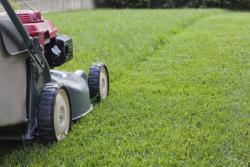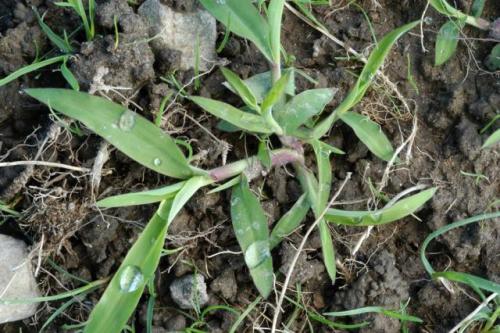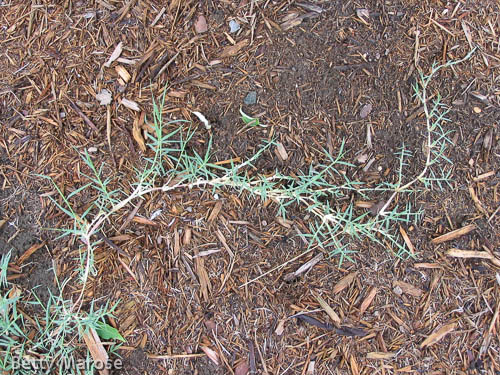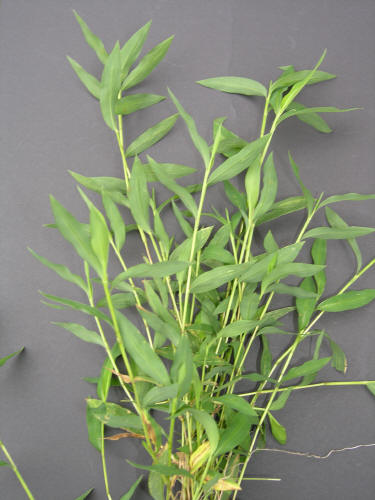Top 5 Weeds — Headaches in Our Summer Lawns
By Sharon V. Smith, former Fairfax Master Gardener Intern
Before we fire up the grill and invite guests over for fun, we survey our outdoor space and notice that growing in the gaps of our patio pavers, our lawn areas and garden beds are unwelcomed plants. This time of year, both annual and perennial weeds are popping up and competing with our cultivated and native plants, and giving us headaches.
 Here are five unwanted annual/perennial weeds:
Here are five unwanted annual/perennial weeds:
- Crabgrass (Digitaria sanguinalis)
- Bermudagrass (Cynodon dactylon)
- Japanese stiltgrass (Microstegium vimineum)
- Spotted spurge (Euphorbia maculata)
- Wild violet (Viola papilionacea)
They are all tough plants and will require management at various times to prevent them from getting the upper hand.
Crabgrass
We probably can remember our fathers complaining about this first, pesky summer annual weed when we were growing up. The noteworthy crabgrass is native to Europe and Eurasia and was introduced in 1849 as a forage crop. It thrives in full sunlight and high temperatures. Its seeds germinate in the spring when the soil temperatures reach 55 to 60 F for two or three consecutive days. It grows through the summer and dies with the first frost.

Crabgrass
It is important to note that crabgrass cannot be controlled in one growing season because of the prolific number of viable seeds it produces. Control will require several seasons of well-timed cultural practices such as increasing mowing height during crabgrass germination periods of spring and early summer, fertilizing to supply adequate, balanced nutrition to your lawn, irrigating to maintain continued turf growth, and reseeding in late summer or early fall to prevent its encroachment.
A crabgrass preventer called a preemergence herbicide can be applied in early spring before the forsythia flowers drop. Most commonly formulated herbicides will also contain a lawn fertilizer. Some common trade names found at your local garden centers include Barricade (prodiamine), Dimension (dithiopyr), and Scotts Halts (pendimethalin). Reseeding cannot be done for 3 to 4 months after herbicide application. If you are seeding a spring lawn, use Tupersan (siduron) with a starter fertilizer. Remember, all preemergence products need water to be activated, so water after applying treatment.
If you have crabgrass already coming up in your lawn, use a postemergence product with quinclorac. Apply it when crabgrass is young and actively growing, and avoid treating lawn grasses during periods of drought or high temperatures.
Bermudagrass

Bermudagrass
Another predator of our beautiful lawns, and second on our top 5 list, is bermudagrass. Considered as both a great turfgrass and a horrible weed, it was first introduced from Africa in 1751. With its stolons and rhizomes, bermudagrass is capable of rooting in the soil and creating new plants as they grow out from the original plant. Even when cut and left on moist soil, the stolons and rhizomes can take root and form a new plant. Because of this problem, preemergence controls have not been effective.
Persistent hand removal is a good option for gaining control over this weed, and since bermudagrass loves full sun, you may find it not growing in the shadier spots of your lawn. For large areas of invasion, a postemergence herbicide may be needed with the active ingredient fenoxaprop (Quinkill Max Crabgrass and Weedkiller) or fluazifop-p-butyl (Gordon’s Ornamec 170 Herbicide). These can be applied in the late spring when bermudagrass produces shoots and leaves. It is important to note that lawn grasses may be temporarily injured when you are targeting bermudagrass with these herbicides; therefore, treat only in spring and fall, and discontinue treatments during midsummer.
Japanese stiltgrass

Japanese Stiltgrass
The next weed on our list is Japanese stiltgrass, a summer annual that was introduced into the United States in Tennessee around 1919. As a result of its use as a packing material for porcelain, stiltgrass is currently found in 16 Eastern states, from New York to Florida. It threatens native understory vegetation by invading disturbed shaded areas such as floodplains or areas prone to natural scouring. The plant resembles bamboo, and mature plants can grow 2 to 3 feet tall. It can spread by seed and vegetatively by rooting at joints along the stem with a new plant emerging from each node.
Since its roots are shallow, stiltgrass can be controlled by hand pulling, which is easier when the soil is wet. Pulling up the adult plants in summer before they drop their seeds will help with next year’s infestation. For larger areas, use a mower to prevent seed production. The key to controlling stiltgrass is improving growing conditions for the desired grass. This will mean correctly timed pruning of large plants shading the area, to get more light into places where stiltgrass has gotten a foothold.
After stiltgrass removal, plant native plants or grass seed suitable to area conditions to stabilize the site. Use Barricade (prodiamine), a preemergence herbicide to prevent reinfestation, or apply corn gluten to prevent those missed seeds from sprouting when soil temperature is 50 F, which normally is around March.
Spotted spurge
Native to the eastern United States, our fourth weed is spotted spurge. It is found close to the ground, with dark green leaves growing in pairs called “opposites” that are one-eighth to one-half inch long and one-eighth inch wide. Frequently, a red spot marking can be found on the leaf halfway down its center vein. A poisonous white sap is secreted when stems or branches are broken. It can be a skin and eye irritant and toxic to some animals, so wear gloves when handling this plant.

Spotted Spurge
This summer annual weed can be found in sparse turf areas and low-growing ground covers. It invades gardens, landscapes and gaps in sidewalks and patios. It is a host for fungal diseases and attracts ants with its seeds. A single spotted spurge plant can produce 1,000 seeds that can remain dormant in the soil until temperatures are 75 to 85 F. A dense mat can grow up to 3 feet in diameter, and growth is rapid with a single plant producing seeds as soon as 5 weeks after germination.
Hand pulling new spotted spurge plants before they produce seeds is effective. Note that mowing is not an adequate control if you find this weed in your lawn, since spotted spurge grows close to the ground. Figuring out why your lawn lacks vigor is key to preventing the appearance of spurge in those bare spots. In your ornamental gardens, applying 2 inches of mulch can keep light from reaching the seeds and thus prevent germination.
Wild violet

Wild Violet
We finish with our “pretty to look at yet don’t be fooled” weed, wild violet. It is a difficult perennial weed to control and can choke out a lawn. In spring, a wild violet produces its well-known purple (white, bicolored, speckled) flowers, but don’t be taken in by its beauty. This sneaky plant produces a self-pollinating flower that stays below the leaves sight unseen, even underground, and drops a large number of seeds. It also spreads by underground stems. Once in your garden or lawn, this weed is difficult to kill. Use a product that contains triclopyr (Weed-B-Gon purple label), and expect to treat this weed repeatedly.
Best practices
Mulch is the best remedy for weeds, along with hand pulling for our gardens. Proper mowing is the primary and most effective mechanical control in preventing weeds in your lawn. Eighty percent of all weedy species can be eliminated from your lawn with regular, proper mowing. If you cut your lawn too short (more than one-third of the lawn’s height), there isn’t enough foliage to sustain healthy growth. Your lawn will start to decline, becoming thin and weak and developing bare patches.
Please use chemicals (herbicides) with caution, and always read the labels and directions carefully. Remember, it is against the law to dispose of any chemical or chemical container in a way that is inconsistent with its label directions. Do not leave the chemical pellets on your hardscapes (driveways, sidewalks, patios) where water runoff could occur, since these chemicals are toxic to fish.
All five weeds are opportunistic, and their seeds will remain dormant in the soil for years. Proper cutting height and prudent fertilization will increase turfgrass vigor and reduce weed production. Weeds will always take advantage of the opportunity to grow and multiply. Keep in mind that what makes gardening fun is getting outside and working in the soil. Weeds force us to tend to our gardens and lawns, and that is really the benefit. So now that you know, go and get your gloves on and go pull. It is a great way to enjoy being outdoors.
Thanks to David Yost, Master Gardener and Plant Specialist at Merrifield Garden Center, for his expert contributions to this article.
Resources
• Postemergent Lawn Weed Control Podcast, Virginia Cooperative Extension Publication Lawn and
Grass, Virginia Tech, Virginia State
• Biology and Management of Crabgrass, University of Massachusetts Extension Center of Agriculture
• Crabgrass – A Real Pain in the Grass Podcast, Virginia Cooperative Extension Publication Lawn and
Grass, Virginia Tech, Virginia State
• Pest Notes: Bermudagrass, University of California Agricultural and Natural Resources Publication
7453, May 2007
• Japanese Stiltgrass in Home Landscapes, University of Maryland Extension
• We Don’t Have Enough Weeds, Barbara Shepherd, Fairfax Master Gardeners
…updated 2022